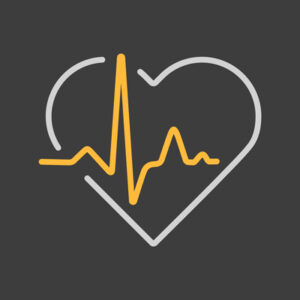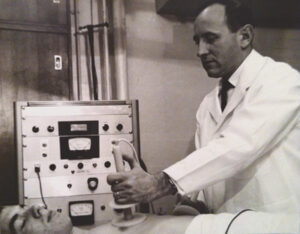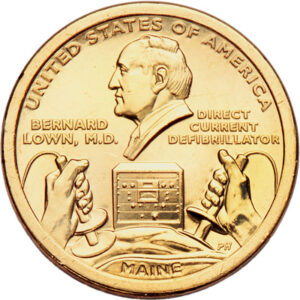Celebrate the life of…
Bernard Lown: Doctor, Innovator & Immigrant
Life in early 1960s America consisted of Beatlemania, lava lamps and banana bikes. This decade would become one marked with societal changes and innovative technology.
Throughout the 1950s, and into the beginning of the 1960s, cardiovascular disease was consistently among the top 5 causes of death in the United States. A deadly disease with a high mortality rate, patients and their families were often left feeling hopeless about their recovery. However, in 1961, one doctor would revolutionize the treatment of cardiac arrhythmias and forever change medicine.

Paging Doctor Lown
Born in Utena, Lithuania on June 7, 1921 to a Jewish family, Bernard Lown understood first-hand the importance of making the world a better place. Looking to escape anti-Semitism making its way across Europe, Lown’s parents made a life altering decision. At fourteen years old, Lown immigrated with his family to the United States in 1935 – four years before the start of World War II.
After settling in Lewiston, Maine, Lown got to work learning an entirely new language. Seven years later in 1942, Bernard Lown would receive his bachelor’s degree from the University of Maine. Determined to make a difference in the world, he would earn his MD from Johns Hopkins University only a few years later.
As a student at Johns Hopkins he would famously become – briefly – expelled. During the 1950’s, blood donations would be separated by the donor’s ethnicity. Lown, who questioned this standard practice, would swap the labels to match the blood bank’s need. After being caught, he was expelled from the school. He would be reinstated a short time later with the support of his fellow students.
In 1951, under the guidance of his mentor Dr. Samuel Levine, Lown again questioned the medical field. At the time, the treatment for heart attacks was to have the patient remain on bed rest for 4-6 weeks. The “Levine Chair Experiment”, where patients who had suffered a heart attack were made to sit up, would disprove the previous practice. The outcome of this study saw a drastic improvement in the outcome of patients and has since become the standard.
The heart of the issue

By the time Dr. Bernard Lown would co-invent the Direct Current Defibrillator in 1961, he had already made significant change in the medical community. But it is this lifesaving invention of Lown’s that has been chosen for the Maine Innovation dollar.
While AC (Alternating Current) Defibrillation had been invented by a doctor several years earlier in 1955, it didn’t have a high success rate. Determined to find a better solution for patients in need, Lown began to work alongside engineer and fellow immigrant Baruch Berkowitz.
Using his working knowledge of the AC Defibrillator, Lown reasoned that by using an alternating current, the heart muscle was actually being damaged. He theorized that by only using one pulse of energy, the heart would be able to better recover – and the DC Defibrillator was born. Several years later, Lown would continue to advocate for cardiac wellness by creating a coronary care unit that specialized in heart arrhythmias at Peter Brigham Hospital (now Brigham and Women’s Hospital) in Boston. Other hospitals would soon follow his example.
While he had the opportunity to patent his invention, he opted not to. By doing this Lown was able to ensure that millions of people around the world would have access to this life-changing technology. Still used today, the success of Lown’s DC Defibrillator has saved countless lives across the globe.
A lasting impact

The 2024 Maine Innovation dollar honors the life and work of a man who would remain dedicated to safeguarding humanity for the rest of his life.
In the decades that followed, Dr. Bernard Lown would go on to:
- Create, with the help of Soviet cardiologist Dr. Yevgeniy Chazov, the International Physicians for the Prevention of Nuclear War
- Win a Nobel Peace Prize
- Found SATELLIFE which would use satellites to give developing countries access to medical literature
- Publish two books
- Found ProCor which would function as a worldwide network to prevent heart disease
- And campaign against privatized healthcare in Massachusetts (the basis of which was used for the Affordable Care Act)
“We physicians who shepherd human life from birth to death have a moral imperative to resist with all our being the drift toward the brink,” Dr. Lown stated in 1985 at his Nobel Peace Prize acceptance speech.
Two years after the death of his beloved wife, Louise, Lown would follow her. On February 16, 2021, at the age of 99, Dr. Bernard Lown passed away having left the world better than he found it.
Following the release of the Illinois’ Steel Plow Innovation dollar and Alabama’s Saturn V rocket Innovation dollar, the Maine Innovation dollar is the third dollar to be released in 2024. The final Innovation dollar for this year from Missouri honors George Washington Carver.
Is your collection of the U.S. Innovation dollars up to date? Which has been your favorite dollar so far?
Sources:
Lown Institute. “Dr. Bernard Lown” Accessed June 20, 2024 https://lowninstitute.org/about/dr-bernard-lown/
Langer, Emily. “Bernard Lown, physician who rallied doctors against nuclear war, dies at 99” Accessed June 20, 2024 https://www.washingtonpost.com/local/obituaries/bernard-lown-dead/2021/02/17/71ce93fc-7121-11eb-85fa-e0ccb3660358_story.html
Gimpel, John R. “In memory of a mentor and inspiration leader: Bernard Lown, MD” Accessed June 20, 2024 https://thedo.osteopathic.org/2021/02/in-memory-of-a-mentor-and-inspirational-leader-bernard-lown-md/
Harvard. “Dr. Bernard Lown” Accessed June 20, 2024 https://www.hsph.harvard.edu/lownscholars/dr-bernard-lown/
Rocks, Jennifer & Smith, Jonathan P. “Dr. Bernard Lown” Accessed June 20, 2024 https://www.mainepublic.org/show/maine-calling/2024-06-07/dr-bernard-lown
International Physicians for the Prevention of Nuclear War. “1985 Peace Prize Acceptance Speeches” Accessed June 21, 2024 https://www.ippnw.org/about/ippnw-a-brief-history/1985-nobel-peace-prize



